
Silicon dioxide, also known as silica, is an oxide of silicon with the chemical formula SiO2, most commonly found in nature as quartz and in various living organisms. In many parts of the world, silica is the major constituent of sand. Silica is one of the most complex and most abundant families of materials, existing as a compound of several minerals and as a synthetic product. Notable examples include fused quartz, fumed silica, silica gel, opal and aerogels. It is used in structural materials, microelectronics, and as components in the food and pharmaceutical industries.

Morgan County is a county located in the U.S. state of West Virginia. As of the 2010 census, the population was 17,541. Its county seat is Berkeley Springs. The county was formed in 1820 from parts of Hampshire and Berkeley Counties and named in honor of General Daniel Morgan, prominent soldier of the American Revolutionary War.

Chert is a hard, fine-grained sedimentary rock composed of microcrystalline or cryptocrystalline quartz, the mineral form of silicon dioxide (SiO2). Chert is characteristically of biological origin, but may also occur inorganically as a chemical precipitate or a diagenetic replacement, as in petrified wood.

Silica gel is an amorphous and porous form of silicon dioxide (silica), consisting of an irregular tridimensional framework of alternating silicon and oxygen atoms with nanometer-scale voids and pores. The voids may contain water or some other liquids, or may be filled by gas or vacuum. In the last case, the material is properly called silica xerogel.

Union Carbide Corporation is an American chemical corporation wholly owned by Dow Chemical Company. It currently employs more than 2,400 people. Union Carbide produces chemicals and polymers that undergo one or more further conversions by customers before reaching consumers. Some are high-volume commodities and others are specialty products meeting the needs of smaller markets. Markets served include paints and coatings, packaging, wire and cable, household products, personal care, pharmaceuticals, automotive, textiles, agriculture, and oil and gas. The company is a former component of the Dow Jones Industrial Average.

Fused quartz,fused silica or quartz glass is a glass consisting of almost pure silica (silicon dioxide, SiO2) in amorphous (non-crystalline) form. This differs from all other commercial glasses in which other ingredients are added which change the glasses' optical and physical properties, such as lowering the melt temperature. Fused quartz, therefore, has high working and melting temperatures, making it less desirable for most common applications.
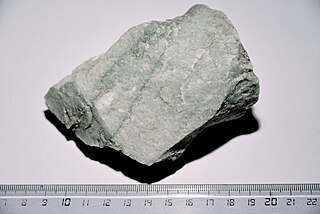
Quartzite is a hard, non-foliated metamorphic rock which was originally pure quartz sandstone. Sandstone is converted into quartzite through heating and pressure usually related to tectonic compression within orogenic belts. Pure quartzite is usually white to grey, though quartzites often occur in various shades of pink and red due to varying amounts of hematite. Other colors, such as yellow, green, blue and orange, are due to other minerals.

Silicosis is a form of occupational lung disease caused by inhalation of crystalline silica dust. It is marked by inflammation and scarring in the form of nodular lesions in the upper lobes of the lungs. It is a type of pneumoconiosis. Silicosis is characterized by shortness of breath, cough, fever, and cyanosis. It may often be misdiagnosed as pulmonary edema, pneumonia, or tuberculosis. Using workplace controls, silicosis is almost always a preventable disease.
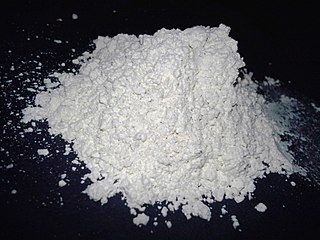
Diatomaceous earth, diatomite, or kieselgur/kieselguhr is a naturally occurring, soft, siliceous sedimentary rock that can be crumbled into a fine white to off-white powder. It has a particle size ranging from more than 3 μm to less than 1 mm, but typically 10 to 200 μm. Depending on the granularity, this powder can have an abrasive feel, similar to pumice powder, and has a low density as a result of its high porosity. The typical chemical composition of oven-dried diatomaceous earth is 80–90% silica, with 2–4% alumina, and 0.5–2% iron oxide.

Hawk's Nest, the site of Hawks Nest State Park, is a peak on Gauley Mountain in Ansted, West Virginia, USA. The cliffs at this point rise 585 ft above the New River. Located on the James River and Kanawha Turnpike, many early travelers on this road stopped to see the view of the river below. In modern times, the Midland Trail carries U.S. Route 60 through the same general route. Ample parking at the overlook in the state park provides tourists with free access to the views.
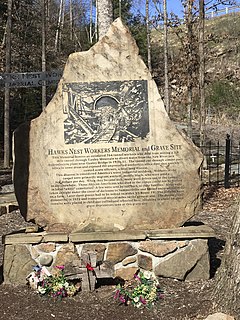
The Hawks Nest Tunnel disaster was a large-scale incident of occupational lung disease as the result of the construction of the Hawks Nest Tunnel near Gauley Bridge, West Virginia, as part of a hydroelectric project. This project is considered to be one of the worst industrial disasters in American history.
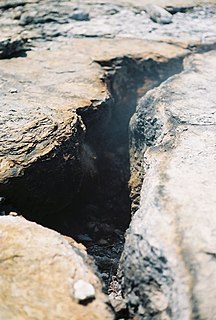
Steamboat Springs is a small volcanic field of rhyolitic lava domes and flows in western Nevada, located south of Reno. There is extensive geothermal activity in the area, including numerous hot springs, steam vents, and fumaroles. The residential portions of this area, located mostly east of Steamboat Creek and south of modern-day SR 341, are now known simply as Steamboat.
Burnt Factory is an unincorporated community in Morgan County, West Virginia north of Berkeley Springs. It is located along Sand Mine Road off Hancock Road and is the site of the U.S. Silica Company's Berkeley Springs plant. U.S. Silica is a producer of ground and unground silica sand, kaolin clay, and aplite. These materials are extracted from Warm Spring Ridge directly across U.S. Route 522 from the facility in Burnt Factory.
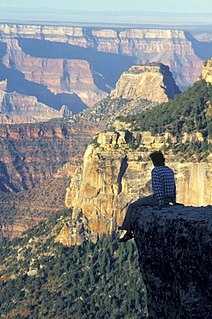
Coconino Sandstone is a geologic formation named after its exposure in Coconino County, Arizona. This formation spreads across the Colorado Plateau province of the United States, including northern Arizona, northwest Colorado, Nevada, and Utah.

In sedimentology and geology, a nodule is a small, irregularly rounded knot, mass, or lump of a mineral or mineral aggregate that typically has a contrasting composition, such as a pyrite nodule in coal, a chert nodule in limestone, or a phosphorite nodule in marine shale, from the enclosing sediment or sedimentary rock. Normally, a nodule has a warty or knobby surface and exists as a discrete mass within the host strata. In general, they lack any internal structure except for the preserved remnants of original bedding or fossils. Nodules are closely related to concretions and sometimes these terms are used interchangeably. Minerals that typically form nodules include calcite, chert, apatite (phosphorite), anhydrite, and pyrite.
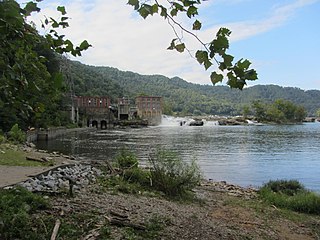
Glen Ferris is a census-designated place (CDP) on the western bank of the Kanawha River in Fayette County, West Virginia, United States. It is situated approximately one mile south of the town of Gauley Bridge. The sole highway linking Glen Ferris to the area is U.S. Route 60, known also as the Midland Trail. As of the 2010 census, its population was 203; the community had 104 housing units, 87 of which were occupied. The village is roughly a mile and a half in length. Glen Ferris is home to two churches, one Apostolic and one Methodist. A railway owned by Norfolk Southern runs parallel to US Route 60 through the village.
Silica or silicon dioxide is a chemical compound.
Silica is an unincorporated community in Saint Louis County, Minnesota, United States.

Davis Memorial Presbyterian Church is a historic Presbyterian church at 450 Randolph Avenue in Elkins, Randolph County, West Virginia, United States. It was originally built in 1894 and 1895 after designs prepared by the Baltimore architect Charles E. Cassell. In 1921, an Akron plan Sunday School building was added to the north by Clarence L. Harding of Washington D. C. The building consists of a nave, an engaged tower, and a gable roofed structure located perpendicular to the nave. It is built of a granular conglomerate stone consisting of large, transparent quartz crystals bound in clay or silica. The style is Gothic, with Romanesque and eclectic influences.
The Huntersville Chert or Huntersville Formation is a Devonian geologic formation in the Appalachian region of the United States. It is primarily composed of mottled white, yellow, and dark grey chert, and is separated from the underlying Oriskany Sandstone by an unconformity. The Huntersville Chert is laterally equivalent to the Needmore Shale, which lies north of the New River. It is also laterally equivalent to a sandy limestone unit which is often equated with the Onondaga Limestone. These formations are placed in the Onesquethaw Stage of Appalachian chronostratigraphy, roughly equivalent to the Emsian and Eifelian stages of the broader Devonian system.

















